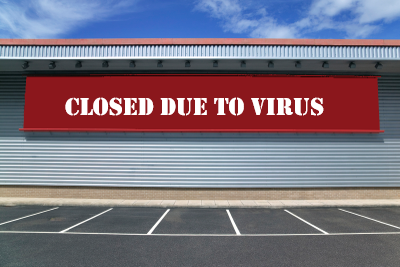Since the onset of the novel coronavirus pandemic, “this too shall pass” has been an oft heard phrase. According to Wikipedia, the phrase traces its roots Persia (modern day Iran). “It reflects on the temporary nature, or ephemerality, of the human condition. The general sentiment is often expressed in wisdom literature throughout history and across cultures, although the specific phrase seems to have originated in the writings of the medieval Persian Sufi poets.” In modern times, the phrase is supposed to offer hope (i.e., reaffirm there is a light at the end of the tunnel). In many communities, churches are ringing bells hoping the joyful noise tolls in a brighter future. Many retailers, however, hear only a death knell. Brick-and-mortar retailers were already struggling with the so-called “retail apocalypse” when the pandemic hit and forced them to shutter physical stores. Re-opening those locations following the pandemic will be problematic.
If retail executives are smart, they will use this downtime to discuss the future of retailing and how it needs to change in order to survive in the years ahead. Imtiaz Mohammady (@nisumceo), CEO of Nisum, writes, “Retail today looks completely different than it did five years ago, and five years from now it will look completely different than it does today. Technology is advancing at a pace that requires retailers to not just keep pace with these changes, but stay ahead of the adoption curve in order to remain competitive and top of mind for consumers.”[1] Now is a great time to learn about those technologies and discuss how they can help revive the retail sector following the end of the pandemic. One thing the pandemic did highlight was the fact that having an omnichannel strategy is now the sine qua non of the retail sector.
What was working before the pandemic?
Anders Melin (@MelinAnders) and Jeff Green (@JeffAGreen) write, “Buying things has never been easier. Selling them, however, is increasingly difficult. Blame changing tastes and the explosion of of online options for killing off numerous retailers and forcing others to rewrite playbooks.”[2] One of the successful retailers Melin and Green discuss is Ulta. Mary Dillon, CEO of Ulta Beauty, told them having an omnichannel strategy was critical for success. “We try not to over-rotate and be only about digital,” she noted, “or only about stores. We need to do both.” When asked about the future of physical stores, Dillon told them, “The narrative about retail absolutely has been wrong. There is a human need … for shoppers to come in person.” Past surveys have shown shoppers still like shopping in person. What is not known is whether the pandemic quarantine will permanently alter consumer shopping behavior. Retail executives must think hard about what will draw consumers back into stores once the pandemic ends.
Price is certainly one factor. Another business leader interviewed by Melin and Green was Eric Lindberg, CEO of Grocery Outlet. Unlike most retailers, Grocery Outlet does not do e-commerce. It sells surplus goods at discounted prices. The company’s supply chain strategy is “opportunistic buying.” Obviously this strategy won’t work for most retailers. I point out the company for two reasons. First, it’s successful because people like low prices. Second, for most people, low prices top convenience every time. Lindberg says he’s asked his customers, “Would you trade some value for convenience? And the resounding answer from customers was ‘no’.” Eschewing convenience for lower prices will be another way to attract consumers back into stores.
Another way successful retailers were winning prior to the pandemic was offering customers great in-store experiences. Great customer experiences will be just as important once the pandemic ends. In the meantime, keeping in touch with clients during the pandemic could also help lure back into stores when it ends. Benish Shah (@benishshah), Chief Growth Officer at Loop and Tie, asserts, “In times of crisis, people want credible information and reliable companies. If you have important (and credible) information to share about the crisis itself, share it. If you are a retail/e-commerce brand that can keep the public updated about merchandise stock to prevent panic-level buying, that’s valuable information. If you are a company that understands distributed workforces and work from home policies, share that knowledge. As brands, and their leaders, look for meaningful ways to engage during an unprecedented crisis — remember that how you behave is more meaningful than any brand message. … People will remember how you made them feel.”[3] Allison Schiff (@OSchiffey), a senior editor for AdExchanger, adds, “It’s less about advertising and more about trying to be helpful, useful and informative.”[4]
Can technology save retail?
Another thing retailers can do to improve survival chances in the wake of the pandemic is leverage cutting-edge technologies. Sharon Goldman (@sharon_goldman) writes, “In the age of coronavirus, technology is playing a big role in boosting resilience but it’s also meeting its match.”[5] She notes, “Large retailers have invested in shoring up their supply chains with modern technology in recent years, including cloud-based omnichannel platforms, AI-driven analytics and IoT sensors that reduce forecasting errors; provide real-time insights into machine functioning; track assets all along the supply chain; and achieve order accuracy.” Mohammady insists retailers need to do even more. He explains, “The next five years will be defined by unified commerce or bringing all disjointed systems together into one system of record that provides cohesiveness and visibility across systems. This integration will allow for a level of personalization that consumers have yet to experience, and a retail journey that is entirely seamless across every channel, device, and touch point with a brand. And all of this will be possible thanks to machine learning, artificial intelligence (AI) and virtual reality (VR).”
Goldman adds, “Companies that have already been on the journey of a digital transformation do have a distinct advantage right now. … Those retailers that have the digital technology to support flexible fulfillment options, such as ship-to-store, order pickup and ship-from-store, will also be ahead of the game.” Not every technology is right for every company. Business leaders need to make a solid business case for each new technology in which they invest. The current crisis is a good time to identify pertinent business cases and decide which technologies are best for addressing them. This will put them a step ahead of the competition coming out of the pandemic. As Goldman concludes, “If possible, retailers should be investing in new software today for tomorrow.”
Concluding thoughts
In a speech prior to becoming president, Abraham Lincoln once stated: “It is said an Eastern monarch once charged his wise men to invent him a sentence, to be ever in view, and which should be true and appropriate in all times and situations. They presented him the words: ‘And this, too, shall pass away.’ How much it expresses! How chastening in the hour of pride! How consoling in the depths of affliction!” For retailers, the fact that the pandemic will end may not be as consoling as it could be. Recovering from the pandemic-caused recession will be difficult; however, retailers preparing now for post-pandemic operations will be those recovering the quickest. Mohammady concludes, “It’s critical that retailers stay ahead of these advances by constantly looking at the ways next-gen technologies can optimize their business, failing fast and pivoting as necessary.”
Footnotes
[1] Imtiaz Mohammady, “Machine Learning, Artificial Intelligence, Virtual Reality And Retailers,” Forbes, 26 February 2020.
[2] Anders Melin and Jeff Green, “Four CEOs Found the Secret to Thriving During the Retail Apocalypse,” Bloomberg, 6 January 2020.
[3] Benish Shah, “How to Market During a Crisis. Short answer: Don’t.” Noteworthy – The Journal Blog, 14 March 2020.
[4] Allison Schiff, “The Dos And Don’ts Of Marketing During A Global Crisis,” AdExchanger, 19 March 2020.
[5] Sharon Goldman, “Can technology save the retail supply chain?” Insider Pro, 30 march 2020.





